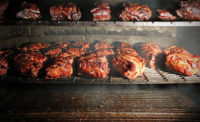Special Report | Portion Control
The challenges of smaller portions
The greater demand by shoppers and merchandisers for meat and poultry in specific portion sizes creates operational challenges for animal producers and processors.




Maximizing meat and poultry revenues in supermarket delis is an intricate undertaking.
Not only must retailers market the optimal quantity and variety of bulk and prepared proteins, but merchandisers also must keep pace with evolving shopper interests while remaining a viable alternative to restaurants and other foodservice competitors.
Size is an increasingly important variable in the development and popularity of meat and poultry selections.
As more consumers and retailers look for protein portions that conform to their health and merchandising needs, processors face the task of efficiently creating exact size products from animals that are becoming bigger and more unwieldy.
Yet offering cuts in the most desired weights is crucial for attracting portion-conscious consumers.
Portion control, for instance, is the third most popular healthy eating tactic behind choosing leaner cuts of meat and limiting second helpings, according to the Power of Meat 2018 report.
Twenty-six percent of shoppers note they regularly cut down on portion sizes, while 55 percent do so occasionally and 20 percent never, the report notes.
When shopping the meat department, 72 percent of consumers from a cross-section of age groups indicate they want to see a variety of package sizes for portion control, the report shows.
The Power of Meat 2018 is published by the Arlington, Va.-based Food Marketing Institute and Washington, D.C.-based Foundation for Meat and Poultry Research and Education and prepared by 210 Analytics, a San Antonio-based market research and marketing strategies firm. Data is from a December 2017 national online sample of 1,500 U.S. adult shoppers who eat meat at home.
Protein manufacturers, meanwhile, are working to keep pace with the greater interest in portion control by developing new selections.
Tyson Foods Inc., for instance, in April began offering chicken packs containing 4-ounce portions in three varieties: marinated chicken breast, rotisserie seasoned diced chicken breast and fajita seasoned chicken breast strips.
The products are a response to shifting market dynamics, including the growth of smaller households, says Megan Huddleston, vice president and general manager of fresh brands at Springdale, Ark.-based Tyson.
“Smaller households are seeking additional benefits like portioning, convenient cuts or kits that save time and waste,” she says.
Across the board
Consumer demand for precise weight and size proteins remains steady in traditional retailer outlets and is increasing in the meal delivery and electronic commerce channels, says Raven Kropf, director of emerging customers and solutions for Wichita, Kan.-based meat and poultry producer Cargill Protein.
“As e-commerce becomes more popular and retailers expand their ‘buy online, pickup in store’ options, as well as other digital options for consumers, portion control will play a stronger role,” she says. “The consumers will want to purchase items in consumption units instead of the estimated weight range that retailers are offering.”
Dollar and convenience stores and meal kit merchandisers also are more likely to sell selections by consumption units rather than varied weights, she notes, adding that “food with a story” — including grass-fed, antibiotic-free and organic options — can be more attractive when merchandised in case ready exact weight packages.
“Such items can be readily available for retailers to sell in store, and exact weights help eliminate complexity in portfolio management by creating standard offerings,” Kropf says.
While smaller single-serve amounts of fresh meat and poultry appeal to shoppers focusing on weight management and waste reduction, convenience is the main purchase driver of portion control offerings, she states.
“Value-added and ready-to-cook items in exact weight and single-serve packages can help address the greater demand for on-the-go eating solutions,” Kropf says. “These offerings are tailored more for consumers in single households and households with finicky eaters.”
Poultry and pork are the most prevalent set weight selections, she says, including chicken breast, turkey cutlets, turkey tenderloins, pork chops and pork tenderloins.
Exact weight beef selections include top sirloin, ground beef patties, stir-fry strips, and middle and end steaks, such as flat iron and ranch steaks, Kropf says, adding “we have not seen as much demand for larger cuts, such as beef roasts.”
Processors can benefit from the increasing market interest in exact weight proteins, she adds, by investing in specialized cutting equipment that can maximize yields by also utilizing byproducts or trimmings.
“Understanding the technologies that exist will help ensure demands are met,” Kropf says.
Thomas Foods International USA, a Swedesboro, N.J.-based producer of Certified Angus Beef-branded ground beef and steaks, is using X-ray cutting equipment for greater precision in creating set weight items while minimizing yield loss, says Michael Forrest, chief executive officer.
He says the company is experiencing significant growth in set weight selections from multiple market segments, including retail, foodservice and electronic commerce.
Demand is driven in part by the greater market interest in meal kits along with cost-minded shoppers seeking smaller selections, including the many Millennials who prefer a per-pack rather than per-pound price, he says.
Back to the farm
Dealing effectively with diverse raw meat compositions, meanwhile, is the biggest hindrance to producing consistent set weight products, he says.
“The more uniform the raw material, the less difficult the job becomes,” Forrest says, adding “every animal will be different, and animals from season to season can be different as well, and that presents challenges when further processing primals.”
He says processors can team with their protein suppliers to increase the consistency of raw meat by setting tight trim and weight specs and sourcing meat from cattle that undergo specific feeding regimes.
Harvesting heavier pigs, poultry, cattle and sheep, which results in larger cuts, is making portion control increasingly important throughout the protein sector, says Norman Marriott, emeritus professor in the College of Agriculture and Life Sciences at Virginia Polytechnic Institute and State University (Virginia Tech) in Blacksburg.
Marriott notes, for example, that the weight of a typical beef carcass in many instances has grown from about 575 pounds to as much as 1,600, while pigs have gone from about 180 pounds to around 280. The increases are driven by producers who are able to generate greater revenues from larger-size animals with relatively minor labor cost increases, he says.
“However, the good news is that equipment manufacturers are making advances in portion control technologies,” he says. “The bad news is that the equipment is expensive and in some cases is difficult to clean. But we there will be more improvements in the future.”
Refinements are likely to better enable processors to more precisely separate muscle from bone in different species, which saves time and makes it easier to develop meat and poultry in exact sizes and weights, Marriott says.
Portion-control machinery also is becoming easier to clean, though the presence of many small moving parts still presents a sanitizing challenge, he says.
Processors seeking state-of-the-art technologies also must have adequate space in their plants for the equipment, and many seek reasonable payback times, which often is one to two years, Marriott says.
The latest versions frequently incorporate imaging systems and algorithms that can analyze the size, weight, shape, thickness and density of varying compositions of meat and poultry in milliseconds and almost instantaneously make the necessary operational adjustments to produce equal portions, such as by changing belt speeds, says Jeff Sindelar, associate professor and extension meat specialist in the Department of Animal Sciences at the University of Wisconsin, in Madison.
“The equipment is not new but the technology has strongly advanced and been refined over the last few years,” he says, noting machinery is becoming more efficient, faster and flexible and that processors most often use the devices for portioning poultry and pork.
“Having exact weights isn’t as critical for beef because consumers for the most part don’t expect it,” Sindelar says. “There is more interest in uniformity for some of the smaller cuts.”
A focus on harvesting meat and poultry from smaller animals, however, can result in higher production costs because lighter carcasses typically have higher per-pound prices, he says, adding the cost of equipment and understanding how to properly maintain and utilize the machinery are among the main challenges to effectively leveraging portion-control technologies.
Money well spent
“There are large capital investments but also greater returns on investment because processors are adding value to a commodity with the technology,” says Keith Belk, a professor in the Department of Animal Sciences and the Center for Meat Safety and Quality at Colorado State University, in Fort Collins.
The processing machinery, he says, is rapidly evolving and includes the use of high-pressure water jets intended to cut meat while reducing waste from the ends and meeting size and weight specifications.
“Such technologies keep getting better and are enabling the processing of more than one type of species on devices,” Belk says. “Having equipment that is easier to clean also is crucial and companies are working with their technology providers on greater enhancements, which can involve machine configurations and construction.”
He notes creating products of specific weights and sizes is particularly challenging when processing beef as many producers still are focusing on developing large animals in order to generate greater revenues.
“There are way more beef variations because majority of beef is marketed like a commodity and pricing is in accordance with weight,” Belk says.
Yet, other proteins also are increasing in size.
The quantity of live chickens weighing 7.75 pounds or greater rose from 6 percent of all birds in 2005 to 21 percent of the total head count and more than 30 percent of total live weight in 2017, says Tom Super, senior vice president of the Washington, D.C.-based National Chicken Council.
He says with convenience a main chicken purchase driver, portion control is crucial for making it easier for consumers to prepare and serve selections.
“With chicken trending toward larger and heavier birds, there is the need to make available more acceptable-sized products, especially for the fresh tray packs that are sold in retail groceries,” which often contain deboned chicken breast and thigh meat, he says.
“Finding that perfect portion for a wide variety of consumers will remain one of the ongoing challenges for successful chicken marketers,” he says. NP
Looking for a reprint of this article?
From high-res PDFs to custom plaques, order your copy today!








